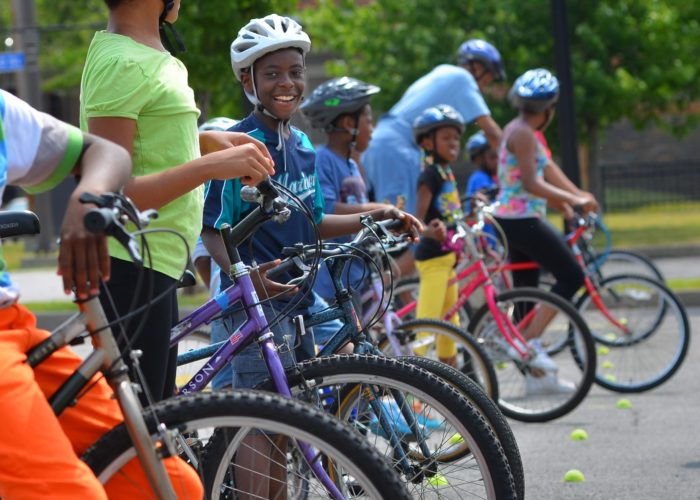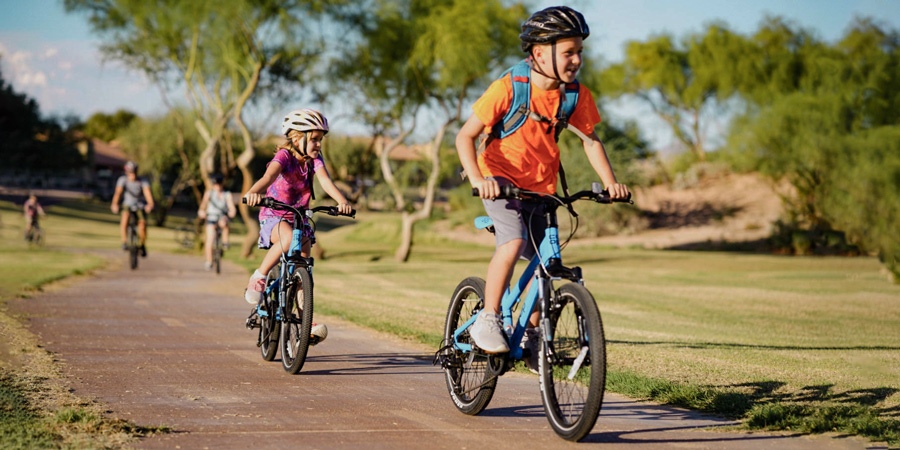Parents help make Walk! Bike! Fun! happen
It’s always a good time to Get Involved
Parents and families play an integral role in supporting Walk! Bike! Fun! (WBF) goals and making walking and biking safer for youth in our communities.

Here’s how Parents can get involved
The resources on this website help prepare adults to initiate activities that reinforce concepts and objectives of the WBF curriculum. These activities can be done in conjunction with an existing WBF program or as standalone efforts. The guide contains background on the Safe Routes to School (SRTS) program, including external references, which provide important context for these supporting activities. We believe (and the research indicates) that the effects of these efforts are maximized when combined as a part of a comprehensive Safe Routes to School program.
Connect Your School Community with Walk! Bike! Fun!
In partnership with Safe Routes to School
LEARN
- Talk to district employees and conduct research to learn about your district’s past involvement in walking and bicycling efforts, if any.
- Talk with a school board member or review any policies and laws that dictate the behavior of the school district.
- Talk with a school board member or administrator to understand the actual distribution of authority between the district and schools – this varies depending on the state and district.
- Check with individual schools to learn about their school policies and how they support or prevent walking and bicycling to school.
- Find out about existing task forces, school teams and initiatives that focus on walking and bicycling to school at individual schools and throughout the district.
- Identify the staff or appointed committees that liaise with school board members or the school principal on transportation decisions and operations.
REVIEW
- Become familiar with the school or school district’s written transportation, health, safety, wellness and other Safe Route to School related policies.
- Read the accompanying Safe Routes to School: A Primer for School Boards and Principals to better understand the strategies and initiatives that school boards and principals can support to increase walking and bicycling.
- Learn the “Six E’s” of Safe Routes to School to understand how a well-rounded policy or program addresses Equity, Engineering, Evaluation, Engagement, Education and Encouragement.
- Utilizing all the information you have learned and reviewed, construct a strong case for Safe Routes to School that will resonate with educational leaders.
- Prepare to connect and participate.
CONNECT
- Develop a working relationship with the school board and/or principal; educate them on key talking points that are relevant to their stated priorities, position and authority.
- Invite a school board member or principal to join the district or community-wide Safe Routes to School task force or to attend a school team meeting to offer more opportunities for collaboration.
- Attend school board meetings to understand the challenges that the district faces and to inform them about the priorities, practices and benefits of bicycling, walking and Safe Routes to School.
PARTICIPATE
- Encourage both school boards and principals to seek funding opportunities to enhance walking and bicycling through programs and infrastructure projects.
- Schedule a Safe Routes to School training for school board members and principals to serve as an expert on walking and bicycling to school programs and projects.
- Ask the school board and principals if they can publicize walking and bicycling initiatives as a viable alternative to taking the bus or the family car on their websites, newsletters and parent back-to-school packets and/or other take-homes.
- Invite school board members and principals to participate in Safe Routes to School events and include them in the planning, implementation, and evaluation process.
- Offer public acknowledgement of school board member and principals’ support and utilize opportunities to demonstrate the positive outcomes of their work.
- Be persistent, professional and understanding. School boards and principals are extremely busy and have multiple priorities

Become a Walk! Bike! Fun! Ambassador
The Walk! Bike! Fun! (WBF) Ambassadors program is a program and educational resource specifically for community members, parents, and volunteers who want to lead and assist with walking and biking initiatives for youth in their town. The Ambassador’s Guide and training prepares adults to implement programs and activities that reinforce concepts and objectives of the complete WBF curriculum, whether or not it is currently being taught in your child’s school. The Ambassador’s Guide contains detailed on information on these topics:
- Ambassadors 101 Fundamentals
- Presentation Essentials
- Walking School Bus
- Bus Stop & Walk / Remote Drop-off activity
- Bike Train
- Walk! Bike! Rodeo!
- Biking and walking mapping
Organize Walk & Bike To School Days
International Walk to School Day
takes place each October, typically on the first Wednesday of the month, to encourage kids to walk to school. Walk to School Day provides students and families the opportunity to reconnect with the simple joys of walking to school while reaping the benefits of increased physical activity, reduced traffic congestion, and arriving at school ready to learn.
National Bike to School Day
takes place each May, typically on the first Wednesday of the month, to encourage kids to bike to school. Bike to School Day is a national event that encourages bicycling (or walking) to school. Students reap the health, community, and academic benefits of a little bit of exercise before school, while having fun riding bicycles with their peers.
Winter Walk to School Day
takes place each February typically on the first Wednesday of the month to encourage kids to walk to school and be active outdoors during the winter. The idea is simple: go for a walk for at least 15 minutes, and don’t let the cold scare you off. Celebrations can start small or include the entire school – just do something!
Getting involved
can be as simple as making an announcement over the school intercom or as involved as coordinating a neighborhood walk or ride with your elected officials, parents, teachers, and community members. Either approach is fun and educational for students, parents and community members alike.
Children who walk or bike to school get more exercise, are healthier, and arrive at school ready to learn. Walking or biking to school also reduces traffic, improving road safety and air quality for all.
Train as a Crossing Guard or School Patrol
The Minnesota Safe Routes to School program is pleased to offer an online training for adult school crossing guards in Minnesota.
This training is not intended to replace existing crossing guard training programs, but it is hoped that it will help provide a standard minimum amount of training for adult crossing guards throughout the state. Other SRTS trainings are available through the MN SRTS Program. MN Crossing Guard , AAA MN School Patrol , and SRTS Academy are just a few. Check out MN SRTS for more info.
Become Certified as a League Cycling Instructor (LCI)
League Cycling Instructors (LCIs) are ambassadors for better biking through education. After earning certification through a 3-day, League Coach-led seminar, LCIs teach Smart Cycling classes to children as well as adults. Their goal is to help people feel more secure about getting on a bike, to create a mindset that bikes are treated as a vehicle, and to ensure that people on bikes know how to ride safely and legally.
Anyone can ride a bike, right? It’s true. Most people can get on and pedal, but many have never been taught to “drive your bike.” At BikeMN, we believe that bicyclists fare best when they act and are treated as drivers of vehicles. BikeMN has worked with partners in Minnesota to apply this nationally recognized principle through the League of American Bicyclists’ proven Smart Cycling Program. We have helped to increase the number of certified League Cycling Instructors (LCI) from 8 in 2008 to more than 200 today. Our ultimate goal is to have LCIs teaching in as many communities throughout Minnesota as possible.
